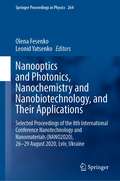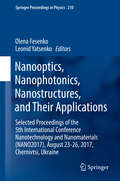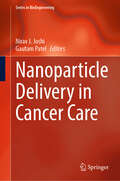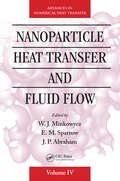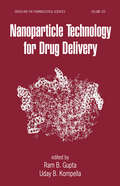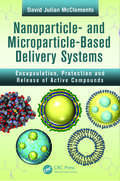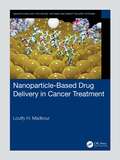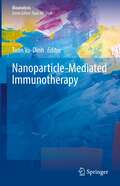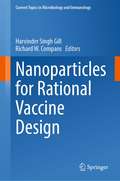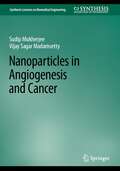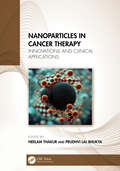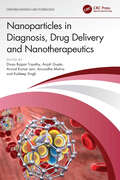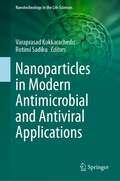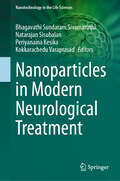- Table View
- List View
Nanooptics and Photonics, Nanochemistry and Nanobiotechnology, and Their Applications: Selected Proceedings of the 8th International Conference Nanotechnology and Nanomaterials (NANO2020), 26–29 August 2020, Lviv, Ukraine (Springer Proceedings in Physics #264)
by Leonid Yatsenko Olena FesenkoThis book highlights some of the latest advances in nanotechnology and nanomaterials from leading researchers in Ukraine, Europe and beyond. It features contributions presented at the 8th International Science and Practice Conference Nanotechnology and Nanomaterials (NANO2020), which was held on August 26–29, 2020 at Lviv Polytechnic National University, and was jointly organized by the Institute of Physics of the National Academy of Sciences of Ukraine, University of Tartu (Estonia), University of Turin (Italy), and Pierre and Marie Curie University (France). Internationally recognized experts from a wide range of universities and research institutions share their knowledge and key findings on material properties, behavior, and synthesis. This book’s companion volume also addresses topics such as nano-optics, energy storage, and biomedical applications.
Nanooptics and Photonics, Nanochemistry and Nanobiotechnology, and Their Applications: Selected Proceedings of the IX International Conference Nanotechnology and Nanomaterials (NANO2021), 25–28 August 2021, Lviv, Ukraine (Springer Proceedings in Physics #280)
by Leonid Yatsenko Olena FesenkoThis book highlights some of the latest advances in nanotechnology and nanomaterials from leading researchers in Ukraine, Europe and beyond. It features contributions presented at the 8th International Science and Practice Conference Nanotechnology and Nanomaterials (NANO2020), which was held on August 25–28, 2021 at Lviv Polytechnic National University, and was jointly organized by the Institute of Physics, the National Academy of Sciences of Ukraine, Lviv Polytechnic National University, University of Tartu (Estonia), University of Turin (Italy), Pierre and Marie Curie University (France), European Profiles S.A. (Greece), Representation of the Polish Academy of Sciences in Kyiv, University of Angers (France), Ruprecht Karl University of Heidelberg (Germany). Internationally recognized experts from a wide range of universities and research institutions share their knowledge and key findings on material properties, behavior, and synthesis. This book’s companion volume also addresses topics such as nano-optics, energy storage, and biomedical applications.
Nanooptics, Nanophotonics, Nanostructures, and Their Applications: Selected Proceedings of the 5th International Conference Nanotechnology and Nanomaterials (NANO2017), August 23-26, 2017, Chernivtsi, Ukraine (Springer Proceedings in Physics #210)
by Leonid Yatsenko Olena FesenkoThis book presents some of the latest achievements in nanotechnology and nanomaterials from leading researchers in Ukraine, Europe, and beyond. It features selected peer-reviewed contributions from participants in the 5th International Science and Practice Conference Nanotechnology and Nanomaterials (NANO2017) held in Chernivtsi, Ukraine on August 23-26, 2017. The International Conference was organized jointly by the Institute of Physics of the National Academy of Sciences of Ukraine, Ivan Franko National University of Lviv (Ukraine), University of Tartu (Estonia), University of Turin (Italy), and Pierre and Marie Curie University (France). Internationally recognized experts from a wide range of universities and research institutions share their knowledge and key results on topics ranging from nanooptics and nanoplasmonics to interface studies. This book's companion volume also addresses topics such as energy storage and biomedical applications.
Nanopackaging
by James E. MorrisThis book presents a comprehensive overview of nanoscale electronics and systems packaging, and covers nanoscale structures, nanoelectronics packaging, nanowire applications in packaging, and offers a roadmap for future trends. Composite materials are studied for high-k dielectrics, resistors and inductors, electrically conductive adhesives, conductive "inks," underfill fillers, and solder enhancement. The book is intended for industrial and academic researchers, industrial electronics packaging engineers who need to keep abreast of progress in their field, and others with interests in nanotechnology. It surveys the application of nanotechnologies to electronics packaging, as represented by current research across the field.
Nanopackaging: From Nanomaterials to the Atomic Scale
by Christian Joachim Xavier Baillin Gilles PouponThis book is a first attempt to merge two different communities: scientists and technologists. Therefore, it is not a general overview covering all the fields of nanopackaging, but is mainly focused on two topics. The first topic deals with atomic scale devices or circuit requirements, as well as related recent technological developments; for example, surface science engineering and atomic scale interconnects studies. The second main part of the book brings CNT nano-materials solutions for resolving interconnect or thermal management problems in microelectronics device packaging. This book is not just useful for those who attended the International Workshop on Nanopackaging in Grenoble, but can provide valuable information to scientists and technologists in the nanopackaging community.
Nanopackaging: Nanotechnologies and Electronics Packaging
by James E. MorrisThis book presents a comprehensive overview of nanoscale electronics and systems packaging, and covers nanoscale structures, nanoelectronics packaging, nanowire applications in packaging, and offers a roadmap for future trends. Composite materials are studied for high-k dielectrics, resistors and inductors, electrically conductive adhesives, conductive "inks," underfill fillers, and solder enhancement. The book is intended for industrial and academic researchers, industrial electronics packaging engineers who need to keep abreast of progress in their field, and others with interests in nanotechnology. It surveys the application of nanotechnologies to electronics packaging, as represented by current research across the field.
Nanoparticle Assemblies and Superstructures
by Nicholas A. KotovCubes, triangular prisms, nano-acorn, nano-centipedes, nanoshells, nano-whiskers. . . . Now that we can create nanoparticles in a wide variety of shapes and morphologies, comes the next challenge: finding ways to organize this collection of particles into larger and more complex systems. Nanoparticle Assemblies and Superstructures, edit
Nanoparticle Delivery in Cancer Care (Series in BioEngineering)
by Nirav J. Joshi Gautam PatelThis book delves into the forefront of cancer treatment, exploring the revolutionary potential of nanoparticle-based drug delivery systems. Authored by leading experts, it provides a comprehensive examination of the latest advancements in nanotechnology and their role in transforming cancer therapy. Covering a broad spectrum of topics—including targeted drug delivery, advanced imaging techniques, and personalized medicine—it presents cutting-edge research and innovations that enhance therapeutic precision, reduce side effects, and improve clinical outcomes. With a focus on transformative technologies, this book is an essential resource for researchers, clinicians, and healthcare professionals aiming to understand and harness the power of nanotechnology in reshaping cancer care, paving the way for more effective and personalized treatment approaches.
Nanoparticle Engineering for Chemical-Mechanical Planarization (Open Access): Fabrication of Next-Generation Nanodevices
by Ungyu Paik Jea-Gun ParkIn the development of next-generation nanoscale devices, higher speed and lower power operation is the name of the game. Increasing reliance on mobile computers, mobile phone, and other electronic devices demands a greater degree of speed and power. As chemical mechanical planarization (CMP) progressively becomes perceived less as black art and more as a cutting-edge technology, it is emerging as the technology for achieving higher performance devices.Nanoparticle Engineering for Chemical-Mechanical Planarization explains the physicochemical properties of nanoparticles according to each step in the CMP process, including dielectric CMP, shallow trend isolation CMP, metal CMP, poly isolation CMP, and noble metal CMP. The authors provide a detailed guide to nanoparticle engineering of novel CMP slurry for next-generation nanoscale devices below the 60nm design rule. They present design techniques using polymeric additives to improve CMP performance. The final chapter focuses on novel CMP slurry for the application to memory devices beyond 50nm technology.Most books published on CMP focus on the polishing process, equipment, and cleaning. Even though some of these books may touch on CMP slurries, the methods they cover are confined to conventional slurries and none cover them with the detail required for the development of next-generation devices. With its coverage of fundamental concepts and novel technologies, this book delivers expert insight into CMP for all current and next-generation systems.
Nanoparticle Heat Transfer and Fluid Flow (Computational & Physical Processes in Mechanics & Thermal Scienc)
by W. J. Minkowycz E. M. Sparrow J. P. AbrahamFeaturing contributions by leading researchers in the field, Nanoparticle Heat Transfer and Fluid Flow explores heat transfer and fluid flow processes in nanomaterials and nanofluids, which are becoming increasingly important across the engineering disciplines. The book covers a wide range, from biomedical and energy conversion applications to mate
Nanoparticle Technology for Drug Delivery (Drugs and the Pharmaceutical Sciences)
by Uday B. Kompella Ram B. GuptaNanoparticles, products of nanotechnology, are of increasing interest to the pharmaceutical community. They can increase drug solubility, enhance bioavailability, allow tissue targeting, offer decreased side-effects, and improve therapeutic efficacy. Presenting the most pertinent and practical issues in the manufacturing and biological application
Nanoparticle- and Microparticle-based Delivery Systems: Encapsulation, Protection and Release of Active Compounds
by David Julian McClementsThis book covers the formation, properties, characterization, and application of different kinds of colloidal delivery systems that can be utilized within the food industry, including surfactant-based, emulsion-based, and biopolymer-based systems. The book takes a traditional colloid science approach to the subject with particular emphasis on the practical aspects of formulation of particulate and emulsion-based delivery systems for pharmaceutical and food applications. It covers active ingredients drawn from proteins, carbohydrates, and lipids as well as mineral-based active ingredients. The book describes particle characteristics and explains mechanical particle fabrication methods.
Nanoparticle-Based Drug Delivery in Cancer Treatment (Nanotechnology for Drugs, Vaccines and Smart Delivery Systems)
by Loutfy H. MadkourThe careful choice of nanoparticles as targets and in drug delivery routes enhances therapeutic efficacy in cancer. Nanoparticle-Based Drug Delivery in Cancer Treatment discusses nanotechnological developments of interfering RNA-based nanoparticles, delivery vehicles, and validated therapeutic RNAi–molecular target interactions and explains the results of clinical and preclinical trials. The book also gives strategies for universal methods of constructing hybrid organic–inorganic nanomaterials that can be widely applied in the biomedical field. Key Features: Reviews recent advances of nanoparticle-mediated siRNA delivery systems and their application in clinical trials for cancer therapy Focuses on material platforms that establish NPs and both localized and controlled gene silencing Emphasizes the most promising systems for clinical application Surveys progress in nanoparticle-based nanomedicine in cancer treatment Describes the most advanced of the nonviral nanocarriers for delivery of oligonucleotides to malignant blood cancer cells This book is a valuable resource for researchers, professors, and students researching drug delivery, gene carriers, cancer therapy, nanotechnology, and nanomaterials.
Nanoparticle-Mediated Immunotherapy (Bioanalysis #12)
by Tuan Vo-DinhThis book is intended to serve as an authoritative reference source for a broad audience involved in the research, teaching, learning, and practice of nanotechnology in immunotherapy. The combination of nanotechnology and immunotherapy is recognized as a promising treatment modality. In particular, the use of nanoparticles in immunotherapy has attracted increased attention for their unique efficacy and specificity in cancer treatment. A wide variety of nanoparticles, such as polymeric and liposomal nanosystems, carbon nanotubes, and gold nanoparticles have provided important nanoplatforms for immunotherapeutic approaches. They have been shown to improve delivery and efficacy of immunotherapeutic agents such as vaccines or adjuvants. Nanoparticle-mediated thermal therapy has demonstrated the effectiveness for precise tumor cell ablation, radio-sensitization of hypoxic regions, enhancement of drug delivery, activation of thermosensitive agents, and enhancement of the immune system. Plasmonic nanoparticles are a special type of metallic nanoparticles that has received great interest due to their enhanced optical and electromagnetic properties and their superior capacity to convert photon energy into heat for selective photothermal therapy at the nanoscale level. Nanoparticle sizes can also be controlled such that they accumulate preferentially in tumors due to the enhanced permeability and retention effect of tumor vasculature. Various nanosystems such as gold nanoparticles have also been shown to stimulate the immune system. Immunotherapies could thus synergistically benefit from the combination with targeted nanoparticle-mediated photothermal therapies, especially when hyperthermia around immune-checkpoint inhibitors in the tumor bed is combined with precise thermal ablation of cancer cells. Of great importance is the possibility that such an approach can induce long-term immunological memory that can provide protection against tumor recurrence long after treatment of the initial tumors, like an ‘anticancer vaccine’. Nanoparticle-mediated immunotherapy could lead to an entirely new treatment paradigm that challenges traditional surgical resection approaches for many cancers and metastases.
Nanoparticles Reinforced Metal Nanocomposites: Mechanical Performance and Durability
by Sabu Thomas Vijay Kumar Santosh K. TiwariThis book highlights recent developments related to fabrication and utilization of nanoparticle-engineered metal matrices and their composites linked to the heavy industries, temperature fasteners, high-pressure vessels, and heavy turbines, etc. The mechanical properties of newly developed metallic composites are discussed in terms of tensile modulus, hardness, ductility, crack propagation, elongation, and chemical inertness. This book presents the design, development, and implementation of state-of-the-art methods linked to nanoparticle-reinforced metal nanocomposites for a wide variety of applications. Therefore, in a nutshell, this book provides a unique platform for researchers and professionals in the area of nanoparticle-reinforced metal nanocomposites.
Nanoparticles and their Biomedical Applications
by Ashutosh Kumar ShuklaNanotechnology is expected to bring revolutionary changes in a variety of fields. This volume describes nanoparticles and their biomedical applications, and covers metal nanoparticles, metal oxide nanoparticles, rare earth based nanoparticles and graphene oxide nanoparticles. It elaborates on a number of biomedical applications, including therapeutic applications. It addresses the topic of green synthesis, in view of increasing health and environmental concerns.
Nanoparticles for Drug Delivery (Gels Horizons: From Science to Smart Materials)
by Sabu Thomas Vijay Kumar Thakur K. S. JoshyThis book introduces the reader to drug delivery with specific emphasis on the use of nanoparticles. It covers properties, characterization, and preparation of different types of nanoparticles and discusses recent advances in their structural design and biomedical application, as well as the issues and challenges associated with their design and use. Some of the topics covered include the potential application of nanoparticles in biomedical fields, hazards associated with use of nanoparticles for drug delivery, size-dependent factors in drug delivery applications, different organic, inorganic and their hybrid systems used in drug delivery, etc. It also highlights use of nanoparticles in controlled and targeted drug delivery, and their application in stimuli-responsive, especially pH-responsive, drug release. Additionally, it also focuses on biomimetic nanoparticles, challenges faced in the designing of nanoparticles for drug delivery in cancer, viral and bacterial diseases. The contents of this volume will be useful to researchers and professionals working on advances in targeted drug delivery systems.
Nanoparticles for Rational Vaccine Design (Current Topics in Microbiology and Immunology #433)
by Richard W. Compans Harvinder Singh GillThis book introduces nanoparticles as a powerful platform for vaccine design. Current challenges in vaccine development are discussed and the unique advantages nanoparticles provide in overcoming these challenges are explored. The authors offer fascinating insights into the immunological assets of using nanoparticles as delivery vehicles or adjuvants and present different materials that are being used in nanoparticle-based vaccine development, covering peptides, proteins, polymers, virus-like particles, and liposomes.Its contemporary research insights and practical examples for applications make this volume an inspiring read for researchers and clinicians in vaccinology and immunology. Chapter "Liposome Formulations as Adjuvants for Vaccines" is available open access under a Creative Commons Attribution 4.0 International License via link.springer.com.
Nanoparticles for Therapeutic Applications (Advances in Nanotechnology and Applications)
by Madhuri SharonNANOPARTICLES FOR THERAPEUTIC APPLICATIONS The main goal of this book is to provide information on theranostic applications of various nanomaterials for different diseases with self-explanatory illustrations and fundamental descriptions of a plethora of properties of molecular traits. The author has written a fascinating book on research topics and fundamentals in the cross-disciplinary area of nanotechnology and bioscience in which she successfully fuses otherwise divergent research topics of this rapidly emerging area. The book deals with the use of nanomaterials for combatting various diseases and disorders of the human body. The three chapters of the first part of this book deal with the areas in which nanotechnology has contributed to nanomedicine. In the second part, different disorders like cancer, neurodegenerative diseases, genetic diseases, infectious diseases, cardiovascular disorders, eye, dentistry, bone, and cartilage-affecting diseases are discussed. In the chapters related to a disease or disorder of a particular organ, a basic brief introduction to them is given as well. Audience The book will be read by researchers, scientists, and graduate students in biotechnology, nanotechnology, materials science, and nanomedicine/biomedicine.
Nanoparticles in Angiogenesis and Cancer (Synthesis Lectures on Biomedical Engineering)
by Sudip Mukherjee Vijay Sagar MadamsettyThis book highlights recent developments of organic and inorganic nanomedicine that play a major role in anti-angiogenic cancer therapy. In addition, the authors present examples of nanomedicine based anti-angiogenic agents and their applications in cancer therapy. Angiogenesis is a pathophysiological phenomenon that modulates cell proliferation and cell migration and plays important roles in cancer. Anti-angiogenic nanotherapies have gained immense attention in recent times as alternative cost-effective therapies that opened a new dimension in cancer theranostics. Further the challenges of the anti-angiogenic nanotherapies and possible future perspective are detailed.
Nanoparticles in Cancer Therapy: Innovations and Clinical Applications
by Neelam Thakur and Prudhvi Lal BhukyaThis book presents the role of nanoparticles in cancer therapy, emphasizing their innovative applications across treatment, diagnosis and the development of therapeutic strategies. The first section of the book describes the applications of nanoparticles in cancer vaccines and gene therapy. It features discussions on polymeric nanoparticles as nanovaccine carriers, membrane-based nano-vaccines for immunotherapy and gene therapy techniques employing nanoparticles. The second section presents advanced nanomedicine approaches, specifying the role of chemodynamic nanoparticles in cancer theranostics, the application of low-dimensional nanomaterials and emerging strategies against drug resistance. Additionally, it explores nanotechnology in radiation therapy, phototherapy modalities and bioengineered virus-like nanoparticles for diagnostics and therapeutics. The last section reviews the clinical applications and prospects, examining theranostic nanoparticles, the clinical translation of nanomedicine and the current limitations of cancer nanotherapy. It also addresses future directions in nanoparticle application, and examines the genotoxicity, immunotoxicity, cytotoxicity assessments, safety profiles, targeted drug delivery, and their role in viral oncogenesis. This book is a useful resource for researchers, clinicians and students in the fields of oncology and nanotechnology.
Nanoparticles in Catalysis (Topics in Organometallic Chemistry #66)
by Shū KobayashiThis volume discusses the great potential of metal nanoparticle catalysts for complicated molecular synthesis and reviews the current progress of this field. The development of highly active and stable heterogeneous catalysts is a crucial subject in modern science. However, development of heterogeneous catalysts for fine chemical synthesis has lagged far behind those for bulk chemical process. In recent years metal nanoparticle catalysts have been of great interest in this area due to their unique activity, ease of heterogenization, and robustness. Therefore, metal nanoparticle catalysts are an excellent candidate for the above-mentioned active and robust heterogeneous catalysts and this book provides an overview of this area. The present volume summarizes recent progress on nanoparticle catalysis for various organic transformations from simple redox reactions to complex asymmetric C–C bond forming reactions and also presents seminal studies on new technologies. It comprehensively summarizes advances in metal nanoparticle catalysis across several aspects including reaction manners, mechanistic investigations and new synthetic methodologies to encourage the use of metal nanoparticle catalysts for future organic synthesis. This volume will be of interest to students, researchers and professionals focused on the next-generation of fine chemical synthesis.
Nanoparticles in Diagnosis, Drug Delivery and Nanotherapeutics (Emerging Materials and Technologies)
by Anuradha Mishra Arvind Kumar Jain Kuldeep Singh Divya Bajpai Tripathy Anjali GuptaThe integration of nanotechnology with biomaterials, diagnostic tools, analytical equipment, physiotherapy kits, and drug delivery agents has resulted in nanotherapeutics illustrated as a class of medicine with potential of research and development. This book illustrates synthesis, properties, and applications of nanotherapeutics in various healthcare-related issues including treatment of cancer, Alzheimer’s disease, targeted drug delivery, anti-HIV-1 nanotherapeutics, antibacterial/antiviral agents, skin therapy, and hyperthermia. Features: Consolidates different aspects of nanoparticles such as synthesis and types of nanotherapeutics in a detailed manner. Presents categorical classification of nanoparticles as therapeutics. Covers the sustainability of nanotherapeutics. Reviews fabrication and advancement of all categories of nanotherapeutics. Discusses specific applications such as in cancer therapy, skin treatments, and targeted drug delivery. This book is aimed at researchers, professionals, and senior undergraduate students in materials and medical science, biomedical engineering, and nanotechnology
Nanoparticles in Modern Antimicrobial and Antiviral Applications (Nanotechnology in the Life Sciences)
by Varaprasad Kokkarachedu Rotimi SadikuNanotechnology-based nanomaterials have revolutionized the field of advanced medical applications by offering new possibilities for treatment and diagnosis. Nano-form materials have become increasingly important in modern healthcare due to their ability to improve bioactivity and therapeutic efficiency. For example, nanomaterials can target specific cells or tissues in the body, which can result in more effective treatments with fewer side effects. However, it is important to carefully control the toxicity of nanomedicine and study its potential toxic effects to ensure patient safety.Moreover, nanomaterials have shown promise in controlling various types of bacteria, viruses, and even SARS-CoV-2. Their small size and unique properties make them effective tools for combating infectious diseases. This book, "Nanoparticles in Modern Antimicrobial and Antiviral Applications," aims to address key issues related to nanoparticles and their potential applicationsin healthcare. The book covers topics such as encapsulated polymer systems and their potential applications in COVID-19 treatment, which are not commonly found in other books. As such, it is a valuable resource for those interested in this field and can provide new insights into the use of nanomaterials for medical applications.
Nanoparticles in Modern Neurological Treatment (Nanotechnology in the Life Sciences)
by Bhagavathi Sundaram Sivamaruthi Natarajan Sisubalan Periyanaina Kesika Kokkarachedu Varaprasad“Nanoparticles in Modern Neurological Treatment" provides a comprehensive exploration of the promising field of nanoparticles and their applications in neurology. The book begins with an introduction, laying the foundation by elucidating the properties and applications of nanoparticles in neurological therapies and diagnostics. The introduction provides an overview of nanoparticles, their properties, and their applications in neurological disorders, discussing the rationale behind using nanoparticles in neurological therapies and diagnostics. Subsequent chapters delve into specific areas of nanoparticle utilization, exploring how nanoparticles are utilized to overcome the blood-brain barrier and effectively deliver therapeutics to the brain for treating various neurological disorders. Nanoparticle-based imaging techniques for diagnosis and monitoring of neurological disorders are examined, along with targeted therapies for neurodegenerative diseases and brain tumors. Additionally, the modulation of inflammation and neuroprotection facilitated by nanoparticles, particularly relevant in conditions like multiple sclerosis and stroke, is discussed. The potential of nanoparticles as biomarkers for diagnosing and tracking neurological disorders is also investigated. Advanced applications include neuroregeneration and repair facilitated by nanoparticles and the emerging field of theranostics combining therapy and diagnosis using nanoparticles in neurological disorders. Lastly, the promising realm of nanoparticle-mediated gene therapy is explored for precision treatment of neurological conditions. By consolidating current knowledge and exploring future potentials, this book seeks to contribute to advancements in neurology, ultimately improving patient outcomes and quality of life.
